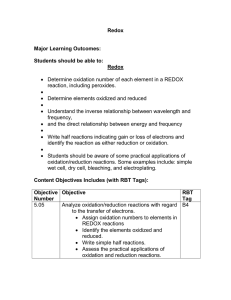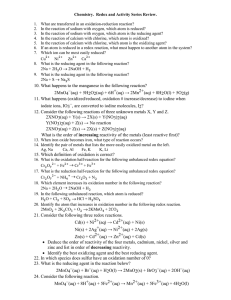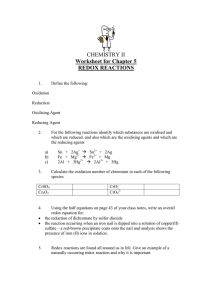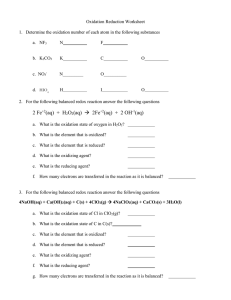IB Chemistry I. Topic 9.1 Review.
advertisement
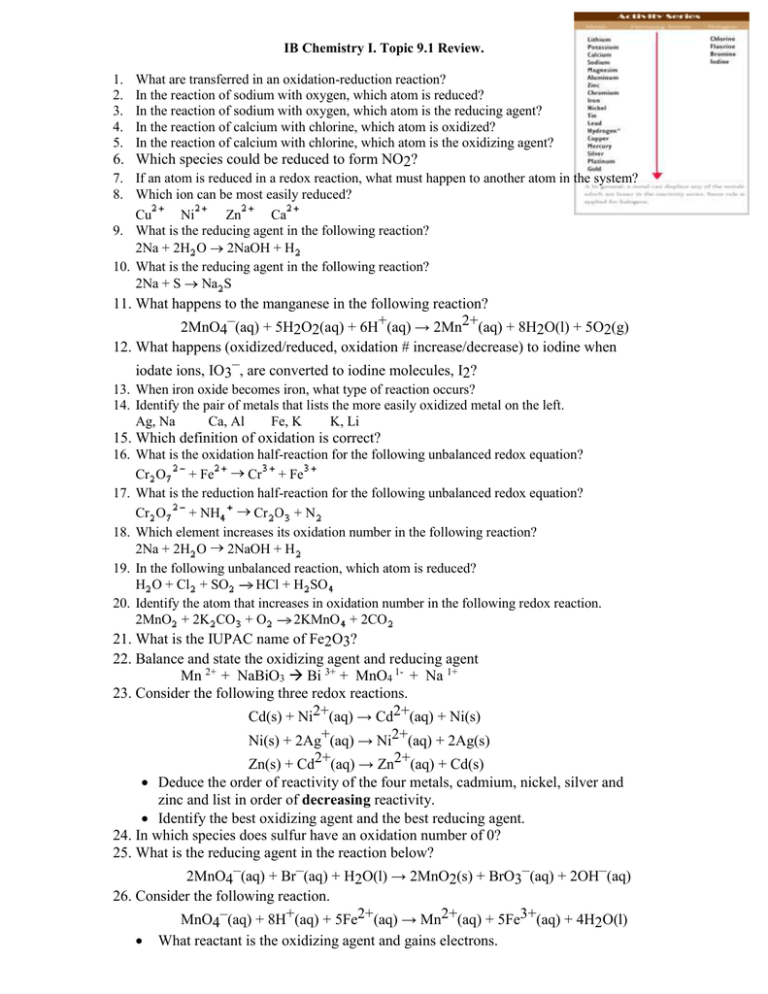
IB Chemistry I. Topic 9.1 Review. 1. 2. 3. 4. 5. What are transferred in an oxidation-reduction reaction? In the reaction of sodium with oxygen, which atom is reduced? In the reaction of sodium with oxygen, which atom is the reducing agent? In the reaction of calcium with chlorine, which atom is oxidized? In the reaction of calcium with chlorine, which atom is the oxidizing agent? 6. Which species could be reduced to form NO2? 7. If an atom is reduced in a redox reaction, what must happen to another atom in the system? 8. Which ion can be most easily reduced? Cu Ni Zn Ca 9. What is the reducing agent in the following reaction? 2Na + 2H O 2NaOH + H 10. What is the reducing agent in the following reaction? 2Na + S Na S 11. What happens to the manganese in the following reaction? 2MnO4–(aq) + 5H2O2(aq) + 6H+(aq) → 2Mn2+(aq) + 8H2O(l) + 5O2(g) 12. What happens (oxidized/reduced, oxidation # increase/decrease) to iodine when iodate ions, IO3–, are converted to iodine molecules, I2? 13. When iron oxide becomes iron, what type of reaction occurs? 14. Identify the pair of metals that lists the more easily oxidized metal on the left. Ag, Na Ca, Al Fe, K K, Li 15. Which definition of oxidation is correct? 16. What is the oxidation half-reaction for the following unbalanced redox equation? Cr O + Fe Cr + Fe 17. What is the reduction half-reaction for the following unbalanced redox equation? Cr O + NH Cr O + N 18. Which element increases its oxidation number in the following reaction? 2Na + 2H O 2NaOH + H 19. In the following unbalanced reaction, which atom is reduced? H O + Cl + SO HCl + H SO 20. Identify the atom that increases in oxidation number in the following redox reaction. 2MnO + 2K CO + O 2KMnO + 2CO 21. What is the IUPAC name of Fe2O3? 22. Balance and state the oxidizing agent and reducing agent Mn 2+ + NaBiO3 Bi 3+ + MnO4 1- + Na 1+ 23. Consider the following three redox reactions. Cd(s) + Ni2+(aq) → Cd2+(aq) + Ni(s) Ni(s) + 2Ag+(aq) → Ni2+(aq) + 2Ag(s) Zn(s) + Cd2+(aq) → Zn2+(aq) + Cd(s) Deduce the order of reactivity of the four metals, cadmium, nickel, silver and zinc and list in order of decreasing reactivity. Identify the best oxidizing agent and the best reducing agent. 24. In which species does sulfur have an oxidation number of 0? 25. What is the reducing agent in the reaction below? 2MnO4–(aq) + Br–(aq) + H2O(l) → 2MnO2(s) + BrO3–(aq) + 2OH–(aq) 26. Consider the following reaction. MnO4–(aq) + 8H+(aq) + 5Fe2+(aq) → Mn2+(aq) + 5Fe3+(aq) + 4H2O(l) What reactant is the oxidizing agent and gains electrons. 27. Fertilizers may cause health problems for babies because nitrates can change into nitrites in water used for drinking. Define oxidation in terms of oxidation numbers. Deduce the oxidation states of nitrogen in the nitrate, NO3–, and nitrite, NO2–, ions. 28. Nitric acid reacts with silver in a redox reaction. __ Ag(s) + __ NO3–(aq) + ____ → __ Ag+(aq) + __ NO(g) + ____ Using oxidation numbers, deduce the complete balanced equation for the reaction showing all the reactants and products. 29. Define oxidation in terms of electron transfer. 30. Chlorine can be made by reacting concentrated hydrochloric acid with potassium manganate(VII), KMnO4. 2KMnO4(aq) + 16HCl(aq) → 2MnCl2(aq) + 2KCl(aq) + 5Cl2(aq) + 8H2O(aq) State the oxidation number of manganese in KMnO4 and in MnCl2. Deduce which species has been oxidized in this reaction and state the change in oxidation number that it has undergone. 31. Which species is oxidized in the following reaction? 2Ag+(aq) + Cu(s) → 2Ag(s) + Cu2+(aq) 32. Which are redox reactions? I. 2FeCl2 + Cl2 → 2FeCl3 II. Mg + 2HNO3 → Mg(NO3)2 + H2 III. H2O + SO3 → H2SO4 33. What is the reducing agent in this reaction? Cu(s) + 2 NO 3 (aq) + 4H+(aq) → Cu2+(aq) + 2NO2(g) + 2H2O(l) 34. Organic matter present in water can be decomposed under aerobic and anaerobic conditions by bacteria. Identify the product, different in each case, when compounds containing the following elements are subjected to aerobic and anaerobic conditions. Element Aerobic decomposition Anaerobic decomposition Carbon Nitrogen Sulfur Phosphorus 35. Water purity is often assessed by reference to its oxygen content. Outline the meaning of the term biochemical oxygen demand (BOD). Describe how the dissolved oxygen concentration in a river would decrease if o a car factory releases warm water into the river after using it for cooling o a farmer puts large quantities of a fertilizer on a field next to the river. 36. An iodine/thiosulfate redox titration is carried out to measure the dissolved oxygen present in a water sample: A 263 cm3 water sample is taken and saturated with oxygen for five days The following reactions (don’t need to know) are related to the Winkler method o 2 Mn2+ (aq) + O2 (aq) + 4OH– → 2 MnO(OH)2(s) o MnO(OH)2(s) + 2 I–(aq) + 4H+ → Mn2+(aq) + I2(aq) + 3H2O o 2 S2O32-(aq) + I2 (aq) → S4O62-(aq) + 2 I– (aq) It was found that 2.7 cm3 of a 0.0584 mol dm-3 solution of sodium thiosulfate (Na2S2O3) was required to react with the iodine produced. o What is the concentration (molarity) of oxygen in the water sample (1.4 x 10-4) o What is the concentration (g dm-3) in the water sample? (4.8 x 10-3) o What is concentration (in ppm) of oxygen in the water sample? (4.79)

